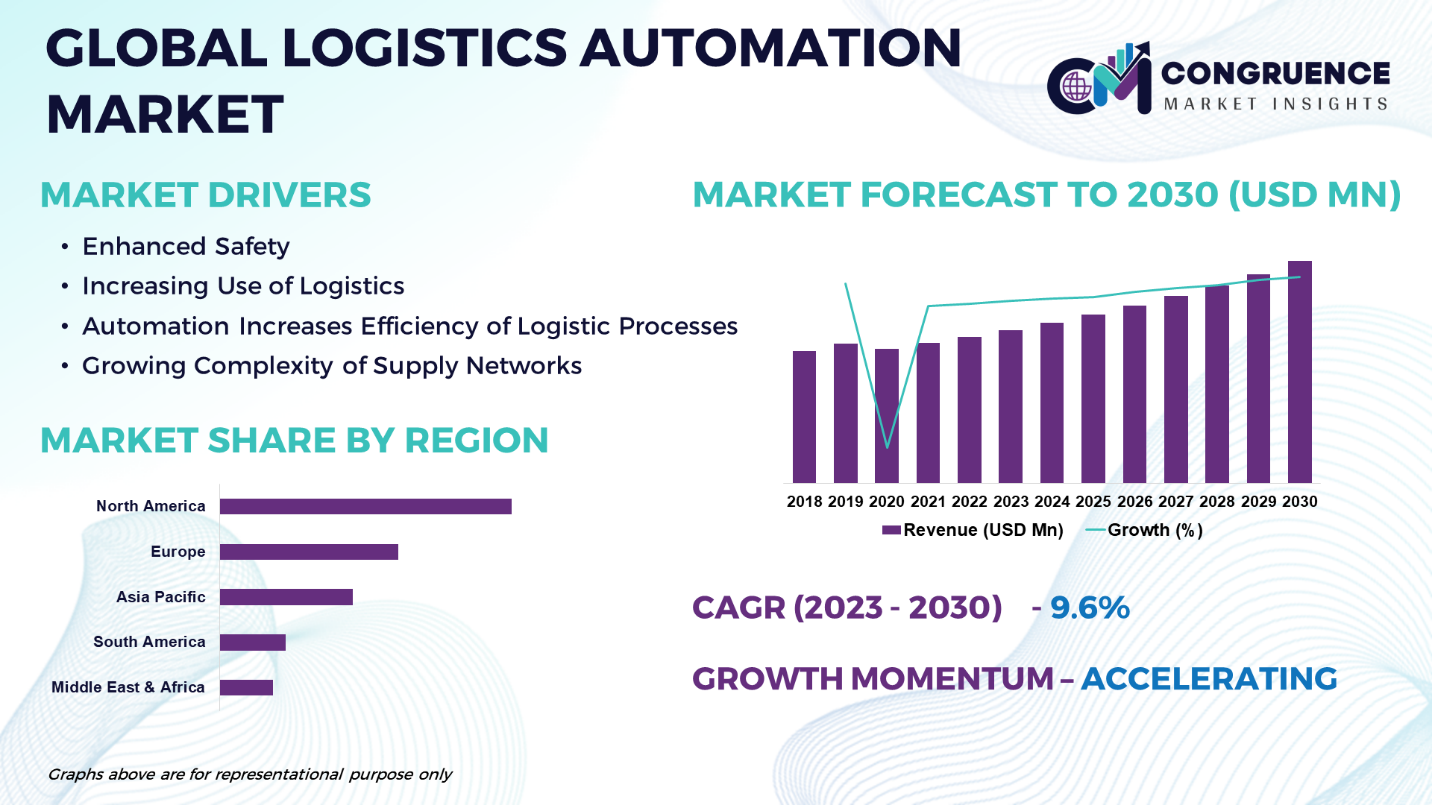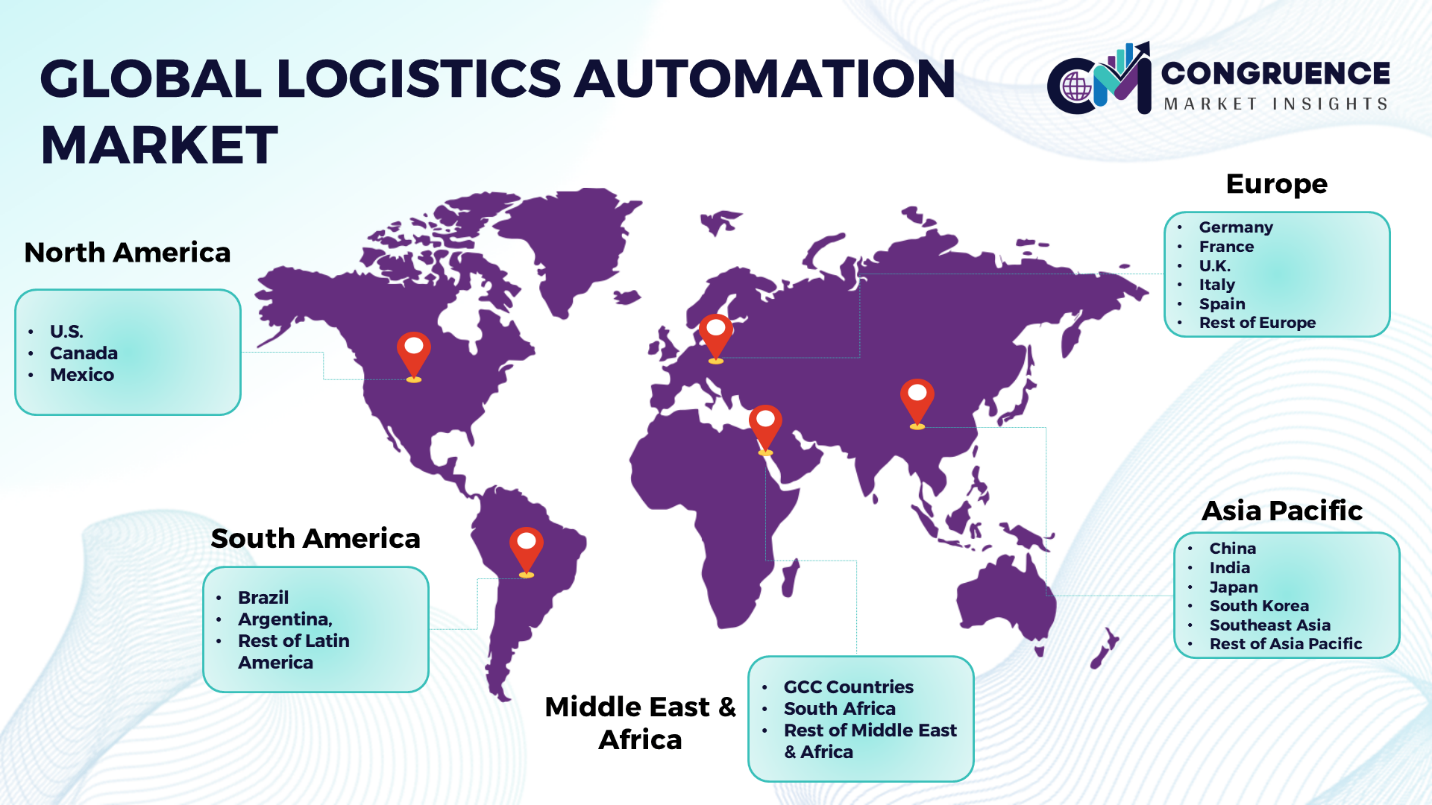Reports
The Global Logistics Automation Market is expected to expand at a CAGR of 9.6% between 2023 and 2030. Automation has improved control, increased efficiency, and benefited the acquisition of a variety of goods. It is also very helpful for inventory management and the production process. Over time, it aids in improving the distribution of different items and customer service. Due to the growing usage of automated vehicles, autonomous mobile robots, robotic arms, and automated retrieval and storage systems, automation in this industry has benefited both transportation and storage. Since software and services are being used more frequently, it has also improved warehouse management. It offers up-to-date information on how the products are being loaded and unloaded. In addition to all of these considerations, the expanding e-commerce industry will necessitate inventory and storage management. An increase in the quantity of warehouses for different items would increase the demand for automation. As supply chains concentrate on boosting the earnings of the companies, the government has established numerous regulations for this sector. Standardization is required in order to automate logistics in Asian countries, which will impede market growth over the projection period. The growing use of cloud-based services also raises the possibility of security and privacy problems. Since sensitive information is accessible on this network, data breaches are frequent. However, this will damage the organization's reputation and have a detrimental effect on its growth. These organizations' ability to conduct business will be jeopardized if all of this data is accessed without authorization. In the upcoming years, all these factors will impede market expansion.

Logistics Automation Market Major Driving Forces
Enhanced Safety: The application of this technology contributes to a decrease in the frequency of accidents and an improvement in workplace safety. The logistics industry is adopting these services and technologies at an increasing rate as they help create a safer working environment for employees, which reduces the chance of accidents and other work-related incidents.
Increasing Use of Logistics: Robotic logistics is becoming more and more popular. Since warehousing is becoming more complicated and businesses need to be able to operate with flexibility and efficiency, they have invested in automated storage and retrieval systems (AS/RS) to automate movements around the facility. Goods are moved efficiently and rapidly between places with the help of robotic assistance. By automating labor-intensive, tedious, and hazardous jobs that are a component of many industries, including as material handling and warehousing, they reduce the demand for physical labor, which leads to market expansion.
Automation Increases Efficiency of Logistic Processes: Organizations can increase their operational efficiency by automating a variety of logistical activities, including order fulfillment, inventory management, and transportation. Automation lowers mistakes, cuts down on wait times, distributes resources optimally, and boosts output all around.
Growing Complexity of Supply Networks: The complexity of supply networks is being driven by market dynamics, globalization, and customer expectations. Logistics automation systems provide supply chain management with visibility, traceability, and agility, allowing businesses to make better decisions, adjust swiftly to changing market situations, and optimize inventory levels.
Logistics Automation Market Key Opportunities
Growth of Autonomous Vehicles: Due to its growing adoption in strictly controlled areas such as yards and warehouses, autonomous vehicle use in logistics has gained significance in recent years. The deployment of autonomous cars in shared and public spaces, such city streets and highways, might be the next significant development for the sector since it would enhance safety and logistics procedures.
Online Retail and E-commerce Growth: The proliferation of e-commerce and online retail platforms presents a prospect for logistics automation manufacturers to broaden their customer base and enhance their market penetration. Global market expansion and product accessibility are made easier by online sales channels.
Cloud-Based Logistics Solutions: The adoption of cloud-based logistics platforms and software-as-a-service (SaaS) solutions presents opportunities for logistics automation providers to offer scalable, flexible, and cost-effective logistics management solutions. Cloud-based platforms enable real-time data sharing, collaboration, and integration across supply chain partners, empowering companies to streamline operations, improve decision-making, and adapt to changing market conditions.
Logistics Automation Market Key Trends
· Automation and Robotics Integration in Distribution and Warehousing Facilities.
· Predictive analytics and optimization through the integration of AI and machine learning.
· The need for drones and autonomous cars for last-mile delivery is growing.
· Growth of Software and Cloud-Based Logistics Platforms.
· Blockchain technology's expansion for supply chain security and transparency.
· Green logistics practices and sustainability are emphasized.
· Growth of Same-Day and On-Demand Delivery Services.
· IoT sensor implementation for real-time tracking and monitoring.
· Put an emphasis on multimodal transportation options for effective freight handling.
· Turn to Logistics Operations That Are Touchless and Contactless.

Market Competition Landscape
The worldwide logistics automation industry is driven by a dynamic blend of established players, creative startups, and technical developments that are reshaping the market. The industry is dominated by major competitors such as KION Group, Amazon Robotics, and Honeywell Intelligrated, who offer extensive portfolios of automated warehousing and distribution solutions. These businesses provide scalable and dependable automation solutions that are customized to meet the demands of various sectors by utilizing their vast knowledge and worldwide reach. A increasing number of startups and IT companies are upending the market alongside more well-established players by introducing cutting-edge automation technology and solutions. At the vanguard of robots and AI-driven logistics automation are businesses notably GreyOrange, Fetch robots, and Geek+, who provide state-of-the-art solutions for order fulfillment, inventory management, and warehouse automation. These firms challenge established players and spur industry innovation by bringing agility, adaptability, and disruptive innovation to the market. Prominent players in the market include:
· Amazon Robotics
· KION Group
· Honeywell Intelligrated
· GreyOrange
· Fetch Robotics
· Geek+
· Dematic
· Swisslog
· Vanderlande Industries
· Daifuku Co., Ltd.
· Bastian Solutions
· KNAPP AG
· SSI Schaefer
· Locus Robotics
· TGW Logistics Group
|
Report Attribute/Metric |
Details |
|
Base Year |
2022 |
|
Forecast Period |
2023 – 2030 |
|
Historical Data |
2018 to 2022 |
|
Forecast Unit |
Value (US$ Mn) |
|
Key Report Deliverable |
Revenue Forecast, Growth Trends, Market Dynamics, Segmental Overview, Regional and Country-wise Analysis, Competition Landscape |
|
Segments Covered |
· By Component (Hardware, Software, Services) · By Function (Goods Sorting and Handling, Warehouse Management, Transportation Management) · By Application (E-commerce, Retail, Healthcare, Automotive, Food and Beverage, Aerospace and Defense, Others) · By End-User (Third-Party Logistics (3PL), Retailers, Manufacturing, Healthcare and Pharmaceuticals, Automotive, Aerospace and Defense, Others) |
|
Geographies Covered |
North America: U.S., Canada and Mexico Europe: Germany, France, U.K., Italy, Spain, and Rest of Europe Asia Pacific: China, India, Japan, South Korea, Southeast Asia, and Rest of Asia Pacific South America: Brazil, Argentina, and Rest of Latin America Middle East & Africa: GCC Countries, South Africa, and Rest of Middle East & Africa |
|
Key Players Analyzed |
Amazon Robotics, KION Group, Honeywell Intelligrated, GreyOrange, Fetch Robotics, Geek+, Dematic, Swisslog, Vanderlande Industries, Daifuku Co., Ltd., Bastian Solutions, KNAPP AG, SSI Schaefer, Locus Robotics, TGW Logistics Group |
|
Customization & Pricing |
Available on Request (10% Customization is Free) |
